
Navigating the complexities of law firm SEO is crucial for lawyers looking to enhance their online visibility and attract more clients.
To do SEO well, you want to optimize your law firm’s website for Google’s ranking factors. But what are those, and why do they matter?
In this article, we’ll explore Google’s algorithm and dive deep into the main Google ranking factors and how to master them to get your law firm’s website to appear higher on search engine results pages.
While Google’s algorithm is always changing, one thing remains the same.
Google’s mission is to:
This ambition drives Google to regularly refine its algorithms to better align with user expectations. It does so by updating the Google Ranking Factors, which number in the thousands (despite the myth that there are “200 ranking factors”).
A basic understanding of the main ranking factors is important for lawyers who want to stay on top of SEO.
Google rewards content that is not only relevant and high-quality but also precisely matches user queries. The goal for lawyers, then, is straightforward: to provide users with the best possible information.
But with so many factors to consider, from domain attributes and core web vitals to backlinks and user interaction, the question is: what should law firms focus on for SEO success?
Thankfully, we don’t have to guess. In 2016, Google Search Quality Senior Strategist Andrey Lipattsev shed light on this question, naming content, links, and RankBrain (focused on understanding user intent) as the three most crucial ranking factors.
Based on my extensive experience with law firm SEO at JurisPage, I believe this trio should be expanded to include three additional pillars: technical SEO, page experience, and onsite optimization. I’d also deprioritize backlinks just a bit, as Gary Illyes of Google has more recently stated,
“We need very few links to rank pages… Over the years, we’ve made links less important.”
We’ll dive more into that in a later chapter, but for now, all you need to know is that it’s always good to seek out reputable, relevant, and high-DA links.
That said, these elements are equally vital in crafting a comprehensive SEO strategy that not only meets but exceeds Google’s criteria.
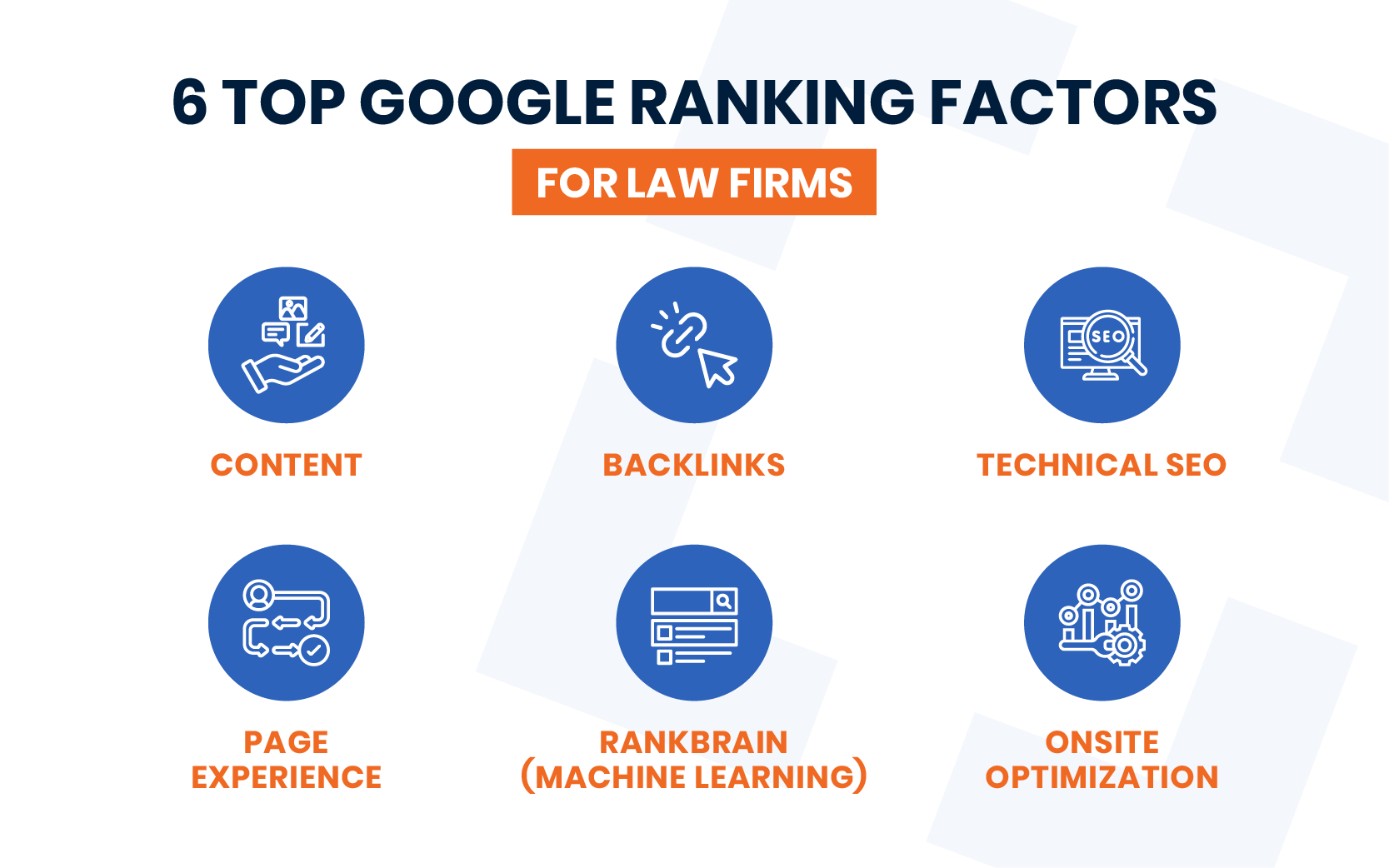
At the end of the day, a smart SEO strategy will hone in on each of these things and invest resources in optimizing for them.
I’m going to cover the six ranking factors in a little more depth to give you a better understanding of how Google views your website.
Content refers to any written or video content optimized and published on a firm’s website.
Writing original, informative content is the cornerstone of law firm digital marketing — and optimized content is a key ranking factor.
It must be topically relevant, optimized for keywords, informative, and easy to read and share.
In addition, all content is ranked on its:
We’ll go into more detail on these factors below.
But first, what type of content should you publish?
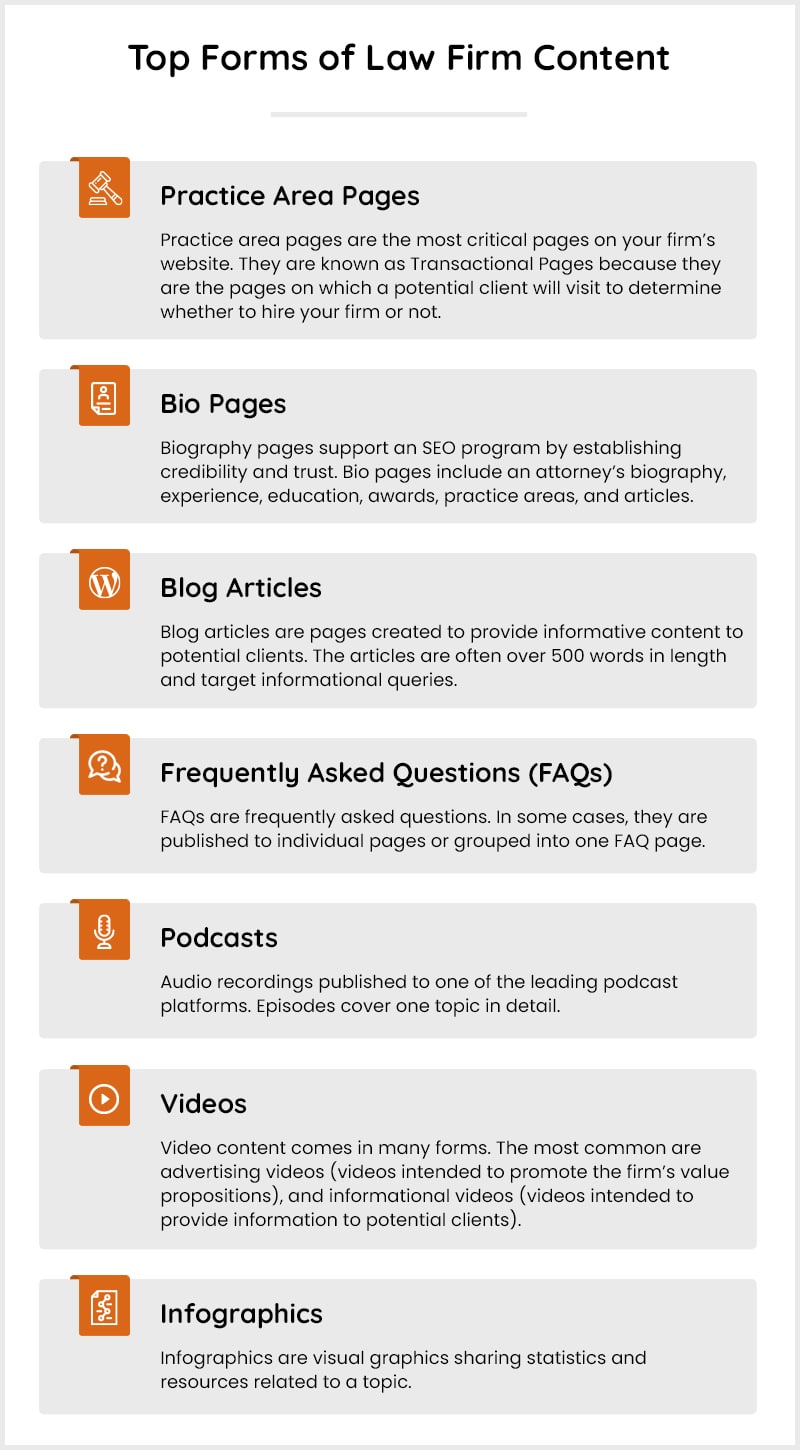
Content creation, be it articles, videos, or podcasts, is one of the most effective marketing techniques for a firm to invest in.
By consistently publishing valuable content, you create the perception of being a subject matter expert. It increases your website and social media traffic, ultimately contributing to more quality sales leads and prospects.
As we’ve mentioned, Google’s aim is to rank the highest quality content that exists. To do that, they evaluate content quality, uniqueness, and freshness.
Quality is self-explanatory.
The best content on a subject is:
At that point, your content should be the most comprehensive and well-structured piece on the internet. But is it unique?
It’s not enough to regurgitate all the same information your competitors put out there.
Your content needs to be different or better than what’s already ranking for the keyword you’re going after.
The above example showcases a child support calculator, which is something that not many law firms include but can attract leads.
Google also cares about freshness — that’s why new content generally gets an (albeit temporary) rankings boost. The key here is to regularly update your content so that it’s up to date.
Most content needs to be updated at least once a year.
Many people fall into the trap of only writing for Google — that is, stuffing in keywords at the expense of user experience.
The truth is great content is written for people first, then optimized for search engines. High-quality content speaks to the reader first, then incorporates keywords and phrases naturally.
Just as important as keyword research is search intent. Make sure your content matches search intent — in other words, your content should answer the intention behind the search. What is the user’s goal when typing those keywords into Google?
There are four types of search intent:
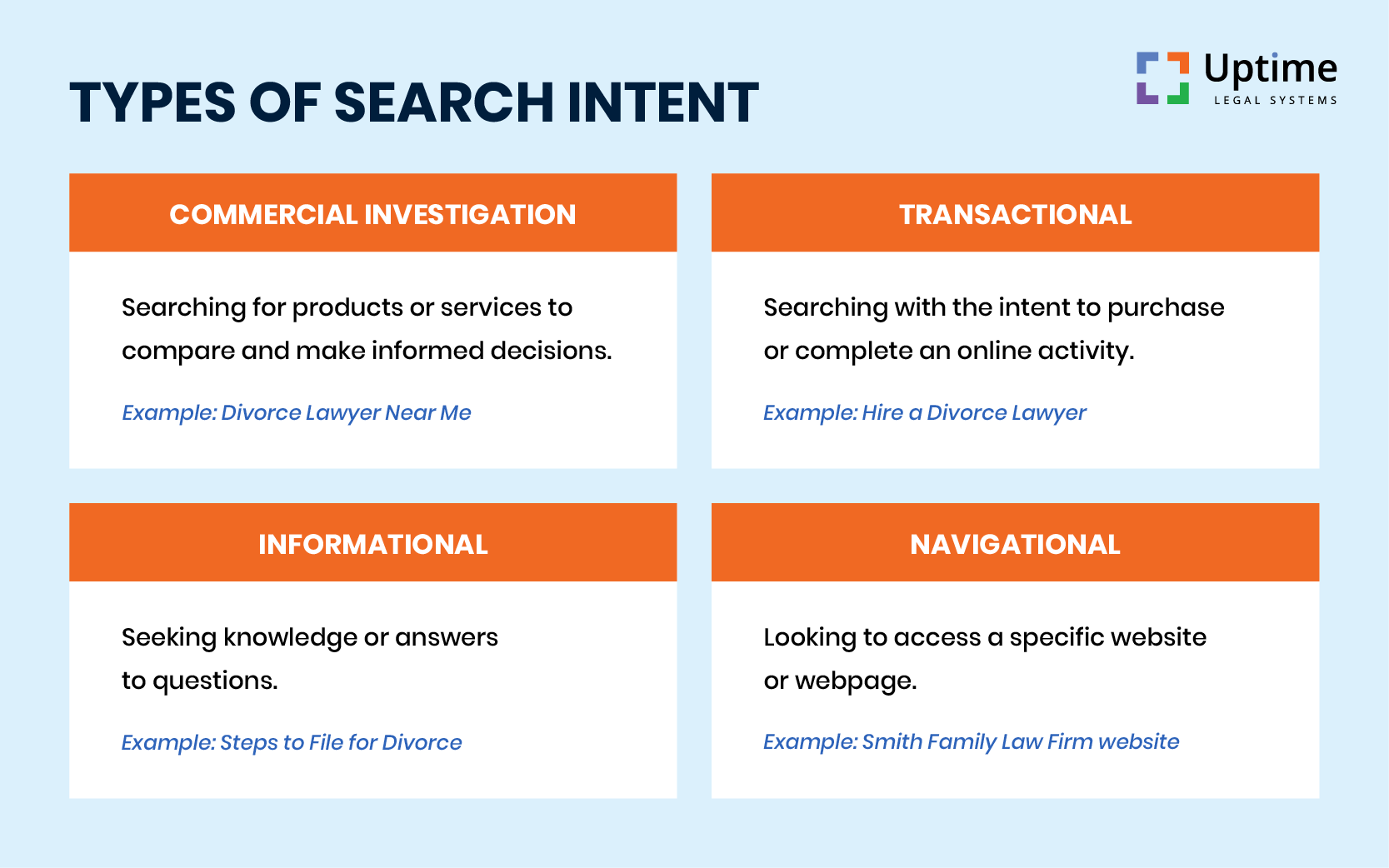
If you know the user’s search intent, you can carefully craft your content so that it specifically answers their query.
For example, someone searching for “file for divorce” could be looking to find information on filing for divorce or explore their options.
If you look at what types of results Google is already showing for that keyword, you can better understand what exactly searchers want and craft your content to address that.
In this case, a searcher is likely looking to hire a divorce attorney in Austin.
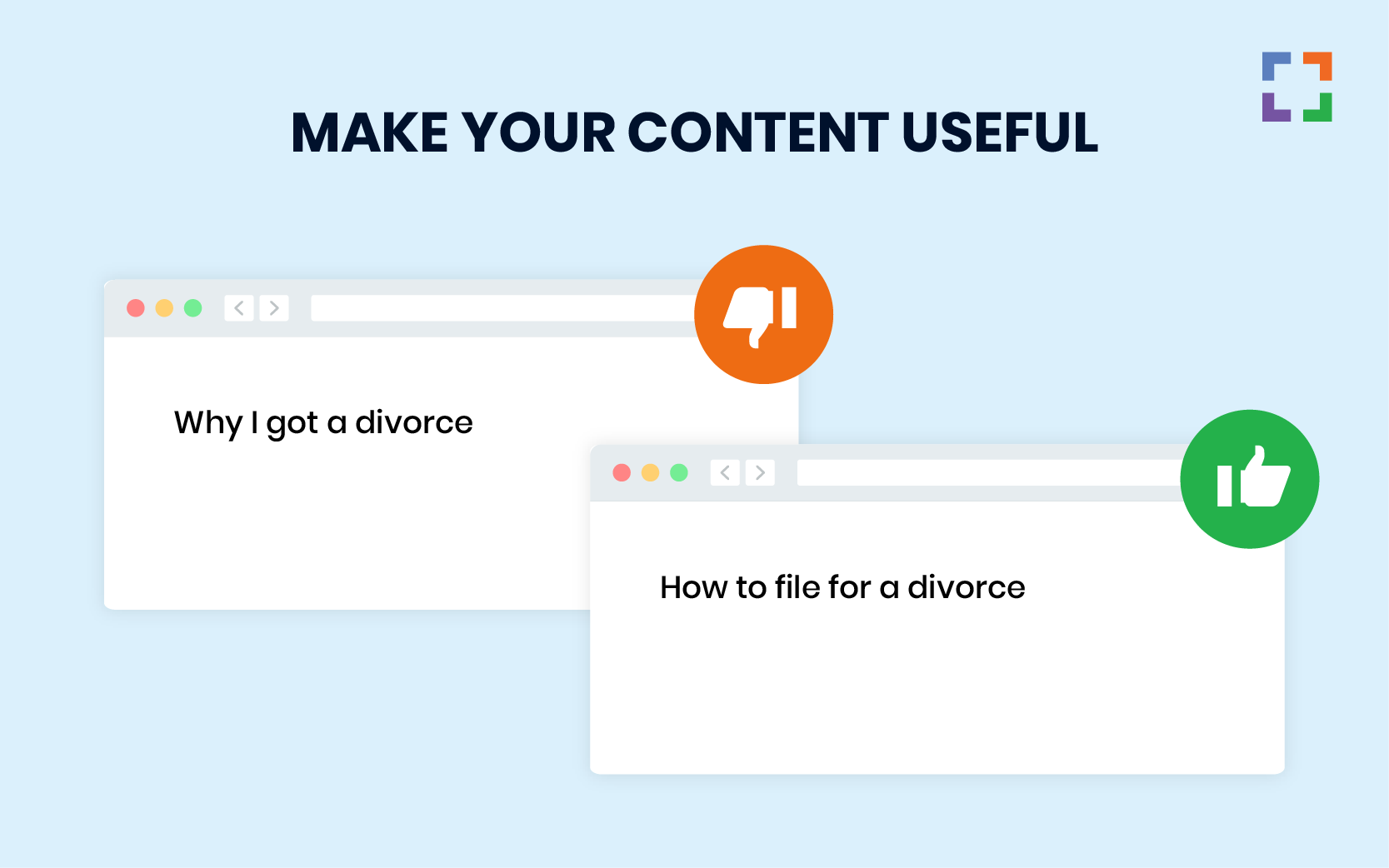
Before we move on, we have to dive into YMYL and E-E-A-T.
YMYL (Your Money Your Life) is a name given (by Google) to types of content that…
Could significantly impact the health, financial stability, or safety of people, or the welfare or well-being of society.
Legal topics fall under this category. Someone searching for an attorney — or just looking for answers to common legal questions — could be in dire need. The answers they land on could significantly impact their welfare.
Google goes the extra mile to ensure YMYL content is accurate and delivered in the best possible way.
To do that, Google puts a greater emphasis on E-E-A-T for all YMYL topics.
Google evaluates a website’s E-E-A-T when deciding where to rank its content — that is, Experience, Expertise, Authority, and Trustworthiness.
To sum it up, you can address YMYL and E-E-A-T by creating exceptional content answers and anticipating audience queries, building valuable insights recognized by others, minimizing negative feedback, and drawing on past experiences.
A backlink is formed when other websites link to your website. The more (and higher quality) backlinks you have to point to your website, the more trustworthy and authoritative Google will view your website.
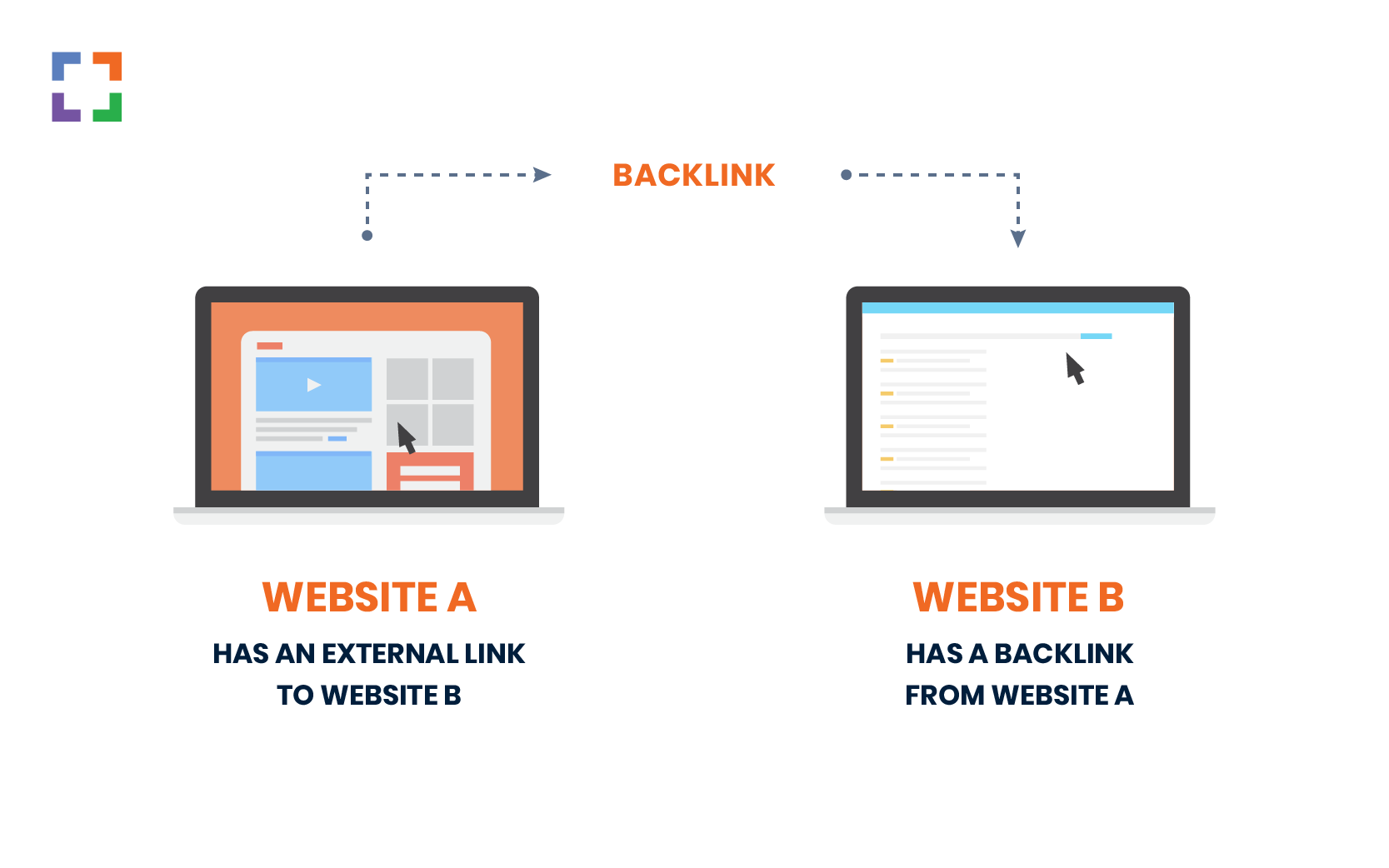
In the above image, website A is linking to website B. Google sees this as a digital vote of confidence.
The more votes (or backlinks) your website has, the more authoritative it appears to Google and the more likely it is to rank well.
What does this mean for you? Think about all of the content that’s out there. Now consider how Google determines which of the thousands of blog posts covering the same topic should be on the first page.
While the impact of backlinks and how their value is calculated has evolved since Google’s introduction, links continue to play a leading role in determining a website’s position in Google’s search results.
Today, quality, relevance, and (to a lesser extent) quantity matter. But what do each of these areas mean?
Why does this matter?
Well, the more quality backlinks you have, the higher your Domain Authority (DA) will be.
Many people say DA is a dead metric, but it has a clear correlation with an increase in sessions.
Take a look at this image, depicting a client’s website shift from 0 DA to 1 DA.
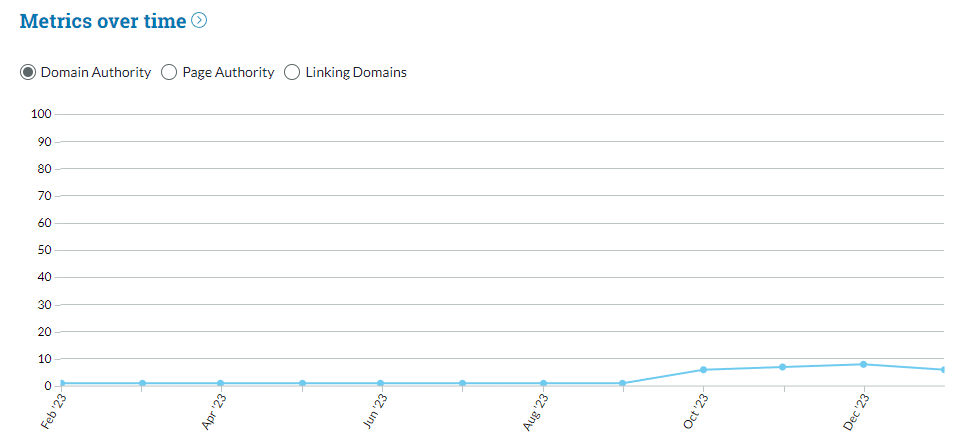
Compare that with the graph below, showing the same website’s increase in website sessions. Notice the correlation between DA and sessions.

Now you know you need authoritative backlinks, but where do you get links?
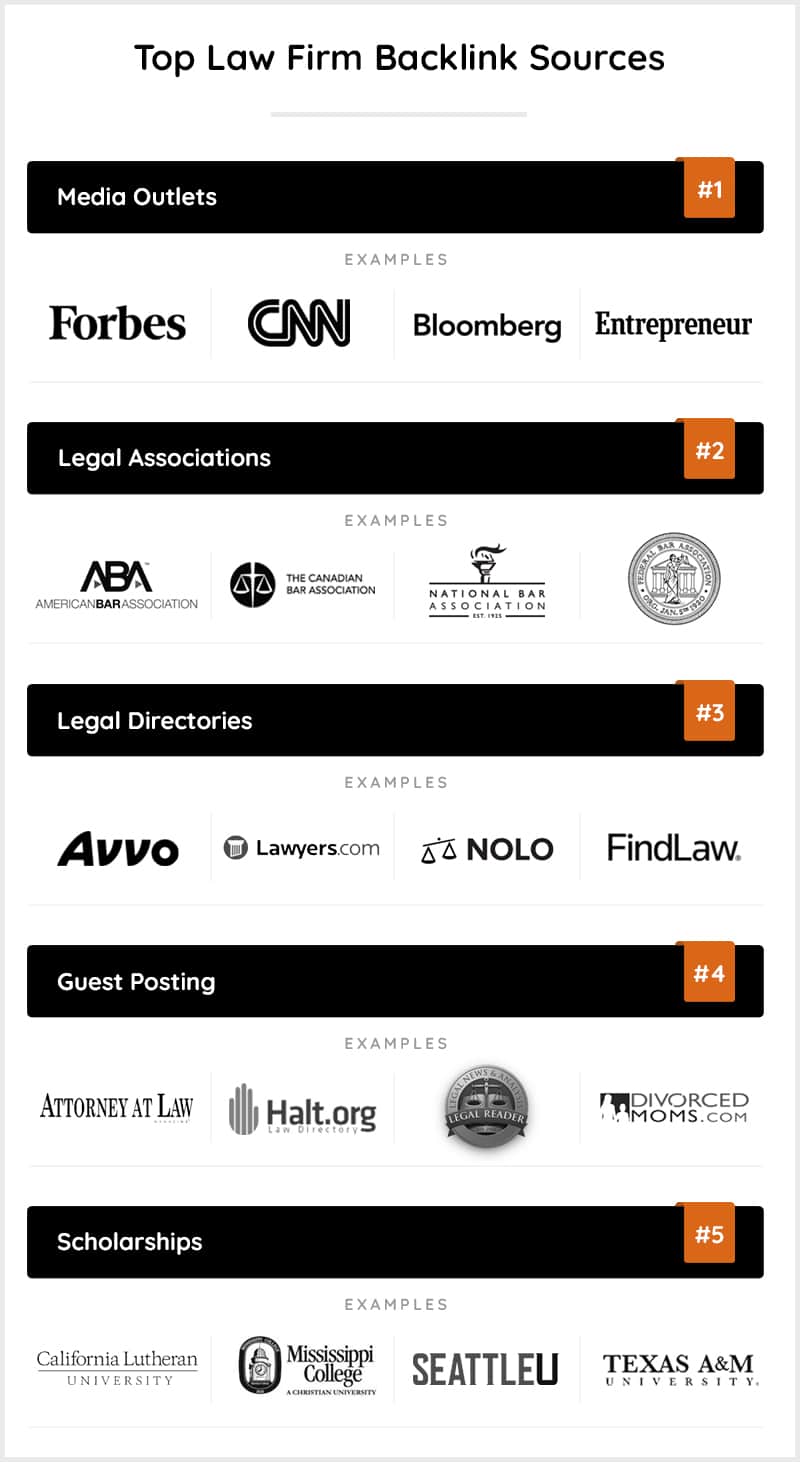
Some other ways to evaluate link quality include:
We’ll touch on this in a bit more detail in our link-building chapter.
We could get really into the weeds when discussing technical SEO, but it wouldn’t do you any good.
Instead, we’ll simply give you some easy-to-implement pointers.
A part of technical SEO that I wanted to highlight is mobile optimization.
With Google’s shift to mobile-first indexing, it’s more important than ever that your law firm’s website is fully optimized for mobile devices. Most modern websites are, by default, at least somewhat optimized for mobile. If you aren’t sure, check out our website on your phone and pay attention to these common mobile problems.
Page experience involves evaluating factors like:
Google announced previously that as of May 2021, certain factors related to page experience would be used in Google Search rankings.
This is what Google had to say:
“At Google Search, our mission is to help users find the most relevant and quality sites on the web. The goal with these updates is to highlight the best experiences and ensure that users can find the information they’re looking for.”
While content is king, page experience comes into play when evaluating multiple pages with similar content.
And Core Web Vitals is one important piece of the puzzle.
Here are the three main Core Web Vital factors to know about.
It can get a bit technical, but the main takeaway is this: if you prioritize user experience (UX), you’ll score well on Core Web Vitals.
User experience is the way people engage with your website and its content.
A well-designed UX guides visitors effortlessly through the process of finding what they need. When they arrive at your site, they can quickly locate the information they seek.
By directly tackling any concerns or problems, you prevent users from becoming frustrated and leaving your site too soon.
The better your UX is, the longer visitors stay on your website and the more likely they’ll contact you. It naturally improves your dwell time and reduces your bounce rate, two easy-to-track parts of Page Experience.
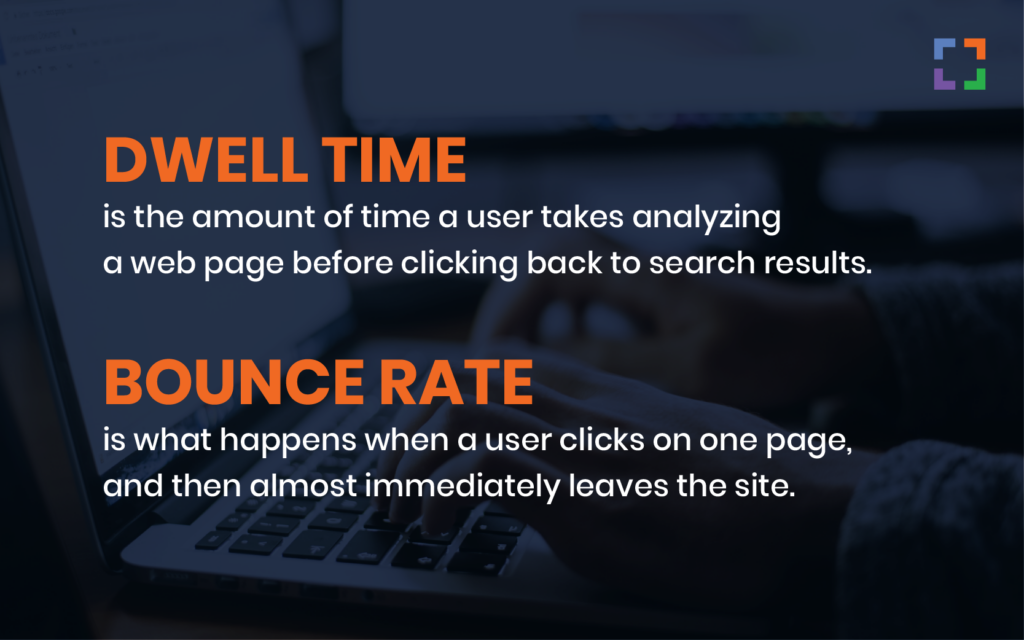
The last thing we want to mention regarding Page Experience is mobile-friendliness.
Did you know that 63% of organic search traffic in the U.S. comes from mobile devices?
That’s a huge majority — and that’s what’s prompted Google to switch to mobile-first indexing. That means Google looks at the mobile version of your website (predominantly) when deciding where to rank your content.
Make sure your website is responsive and mobile-friendly. A responsive website will automatically adapt to the screen it’s being viewed on for a pleasing experience on all devices, including mobile.
RankBrain is the name of Google’s machine learning algorithm, which predicts user intent when someone searches for a term. Part of the Hummingbird algorithm, it assesses what a user means when they type a search term before returning appropriate results.

Remember the following factors when optimizing your law firm website for RankBrain:
RankBrain analyzes user experience signals, such as organic click-through rate, bounce rate, and dwell time, to determine the relevance and value of web pages.
For instance, if RankBrain observes that a particular law firm’s website consistently achieves high click-through rates and users spend a significant amount of time on the site, it interprets these behaviors as signals of high-quality, helpful content — which can result in a boost in rankings of these pages for related search queries.
This intelligent processing allows RankBrain to refine search results in real-time so that users are presented with the most helpful information.
One of the main Google Ranking Factors is page-level optimization — also known as onsite optimization.
This relates to how well the text and media on your page are optimized for search.
It’s an expansive topic, and we go into each of the main factors in the dedicated section on onsite optimization. But for now, it’s enough to acknowledge the importance of the following items.
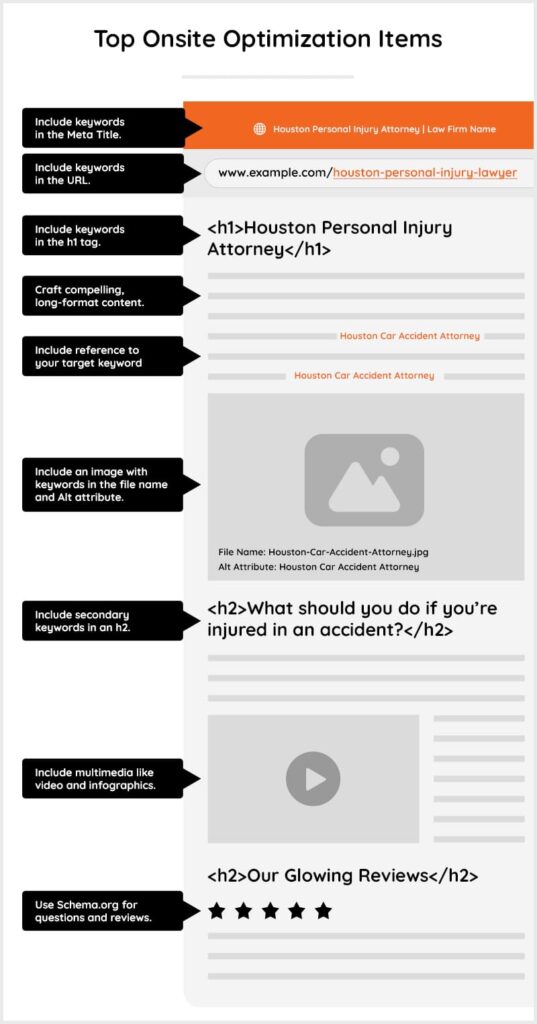
A lot goes into SEO for lawyers. Learning about the main Google Ranking Factors is a great place to start before implementing an action plan.
But remember that Google’s ranking factors and algorithms are always evolving. To stay on top of SEO, it’s important to stay up to date on what’s going on with Google.
If you’re looking for law firm SEO services, reach out for a free consultation.
Ready to maximize your marketing budget? Fill out the contact form or call us today for a complimentary consultation. We will listen to your story, work to define your business objectives, and recommend an approach to deliver maximum ROI for your firm.
By using this website, you consent to our use of cookies in accordance with our Cookie Policy. Cookies help us enhance your browsing experience and provide personalized content. If you do not agree to our use of cookies, please adjust your browser settings accordingly.